신생아의 팔과 다리, Arms and legs of newborn infants
- 태어나기 전 태아들은 좁고 제한된 자궁 강 속에서 40주 동안 성장 발육하면서 자궁 강의 크기와 모양에 적합하게 전신의 체적을 최소한도로 적게 태위를 취한다.
- 대부분의 신생아들과 영아들은 태어난 후 생후 첫 몇 주 동안 자궁 강 속에서 취했던 태위를 그대로 계속 유지한다.
- 자궁 속에서 태아의 턱은 앞가슴에 대고 두 팔꿈치는 가슴 앞으로 오므린 채 두 팔을 앞가슴에 대고, 두 무릎을 오므린 채 두 다리를 배에 갖다 대는 태아의 자세를 태위라고 한다.
- 태아가 자궁강 속에서 신체의 총 체적을 최소한도로 작게 하려고 이런 태위를 취한다.
- 자궁 내에서 이런 체위를 취하고 있는 동안 발이 정상적으로 외반 될 수 있고 때로는 내반될 수 있다.
- 부모도 반의사가 되어야한다-소아가정간호백과-제 16권 소아청소년 정형외과 질환-내반지, 모지외반 참조 자궁 강 내에서 태위를 취했다가 출생 후 이 넓은 세상으로 태어난 후에는 더 이상 태위를 취할 필요가 없다.
- 출생 후 태위를 취하는 현상은 생후 몇 개월 동안 지나면서 점차로 없어진다.
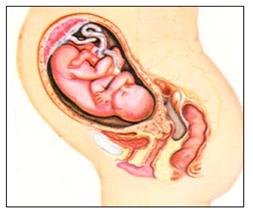
그림2-203.자궁강 내 태아의 체위
Copyright ⓒ 2011 John Sangwon Lee, MD., FAAP

그림2-204.자궁 내 태아의 체위
Copyright ⓒ 2011 John Sangwon Lee, MD., FAAP
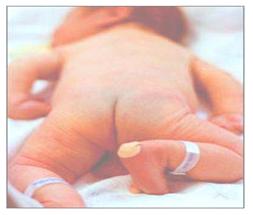
사진 2-205. 출생 후 얼마동안 태아 체위(태위)를 아직도 취하고 있는 신생아
Copyright ⓒ 2011 John Sangwon Lee, MD., FAAP

사진2-206.출생 후 얼마동안 태아 체위를 취하고 있는 신생아
Copyright ⓒ 2011 John Sangwon Lee, MD., FAAP
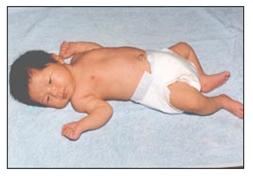
사진2-207.신생아의 머리를 한 쪽으로 돌릴 때 얼굴을 향한 쪽의 팔과 다리는 뻗치고 그 반대쪽의 팔과 다리는 오므리는 원시 반사(원시적 반사)가 생긴다. 이런 반사를 긴장성 경반사(Tonic neck reflex)라고 한다. 이런 반사도 자연히 생긴다.
Copyright ⓒ 2011 John Sangwon Lee, MD., FAAP
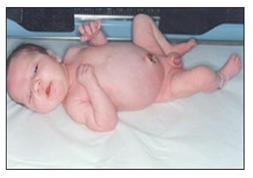
사진 2-208. 신생아의 머리를 한 쪽으로 돌릴 때 얼굴이 향한 쪽의 팔은 뻗치고 그 반대쪽의 팔과 다리는 오므리는 원시 반사가 생길 수 있다. 이런 원시 반사를 긴장성 경반사라고 한다.
Copyright ⓒ 2011 John Sangwon Lee, MD., FAAP

사진 2-209.신생아의 예쁜 손
Copyright ⓒ 2011 John Sangwon Lee, MD., FAAP

사진 2-210.신생아의 예쁜 손
Copyright ⓒ 2011 John Sangwon Lee, MD., FAAP
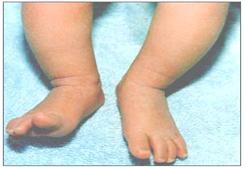
사진 2-211.갓 태어난 신생아의 정상 두 다리와 발
생리적 o형 다리를 볼 수 있다.
Copyright ⓒ 2011 John Sangwon Lee, MD., FAAP

사진 2-212.갓 태어난 신생아의 정상 발과 다리
Copyright ⓒ 2011 John Sangwon Lee, MD., FAAP
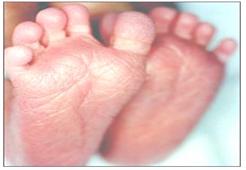
사진2-213.갓 태어난 신생아의 정상 발바닥
Copyright ⓒ 2011 John Sangwon Lee, MD., FAAP
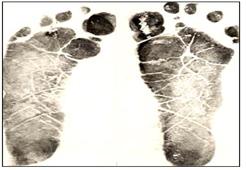
사진2-214.갓 태어난 신생아의 발바닥 프린트(발 도장)
Copyright ⓒ 2011 John Sangwon Lee, MD., FAAP
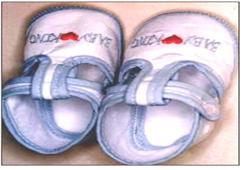
사진2-215.신생아의 신발
발을 따뜻하게 보온할 수 있고 편안함을 주며 발이 조이지 않고 넉넉하고 비싸지 않고 보기 좋은 신발은 가장 좋은 신발이다.
Copyright ⓒ 2011 John Sangwon Lee, MD., FAAP
Arms and legs of newborn infants 신생아의 팔과 다리
- Before birth, the fetus grows and develops for 40 weeks in a narrow and limited uterine cavity, and takes the body volume to a minimum to fit the size and shape of the uterine cavity.
- Most newborns and infants maintain the position they had in the uterine cavity for the first few weeks after birth. In the womb, the fetus’s chin is placed on the forelimbs, his elbows are folded in front of the chest, his arms are placed on his chest, his knees are closed and his legs are placed on his stomach.
- The fetus takes this position to minimize the total volume of the body in the uterine cavity. While in this position in the womb, the foot can be valgus normally and sometimes varus.
- Parents should also be at least the half-doctors-Encyclopedia of Pediatrics and Family Nursing-Volume 16 Pediatric and adolescent orthopedic diseases-Refer to the varus ring and valgus.
- There is the phenomenon of postnatal position gradually disappears over the course of several months.

Figure 2-203. Fetal position in the uterine. cavity Copyright ⓒ 2011 John Sangwon Lee, MD., FAAP

- Figure 2-204. The position of the fetus in the womb. Copyright ⓒ 2011 John Sangwon Lee, MD., FAAP

- Photo 2-205. Newborns who are still in the fetal position for some time after birth. Copyright ⓒ 2011 John Sangwon Lee, MD., FAAP

- Picture 2-206. Newborn in the fetal position for some time after birth. Copyright ⓒ 2011 John Sangwon Lee, MD., FAAP

- Picture 2-207. When the newborn’s head is turned to one side, the arms and legs on the side facing the face are stretched, and the arms and legs on the other side are constricted. These reflexes are called tonic neck reflexes. These reflections also occur naturally. Copyright ⓒ 2011 John Sangwon Lee, MD., FAAP

- Photo 2-208. When a newborn’s head is turned to one side, a primitive reflex may occur in which the arm on the side facing the face is stretched and the arms and legs on the other side are closed. These primitive reflexes are called tonic neck reflex. Copyright ⓒ 2011 John Sangwon Lee, MD., FAAP

- Photo 2-209. A newborn baby’s pretty hands. Copyright ⓒ 2011 John Sangwon Lee, MD., FAAP

- Picture 2-210. A newborn baby’s pretty hands. Copyright ⓒ 2011 John Sangwon Lee, MD., FAAP

- Photo 2-211. Normal two legs and feet of a newborn baby. You can see the physiological O shaped legs. Copyright ⓒ 2011 John Sangwon Lee, MD., FAAP

- Photo 2-212. Normal feet and legs of a newborn baby. Copyright ⓒ 2011 John Sangwon Lee, MD., FAAP

- Picture 2-213. Normal soles of newborn babies. Copyright ⓒ 2011 John Sangwon Lee, MD., FAAP

- Picture 2-214. The footprint of a newborn baby (foot stamp). Copyright ⓒ 2011 John Sangwon Lee, MD., FAAP

- Picture 2-215. Newborn baby’s shoes. Shoes that can keep your newbor feet warm and comfortable, are not tight, are not expensive, and look good are the best shoes. Copyright ⓒ 2011 John Sangwon Lee, MD., FAAP
출처 및 참조 문헌
- NelsonTextbook of Pediatrics 22ND Ed
- The Harriet Lane Handbook 22ND Ed
- Growth and development of the children
- Red Book 32nd Ed 2021-2024
- Neonatal Resuscitation, American Academy Pediatrics
- www.drleepediatrics.com 제1권 소아청소년 응급 의료
- www.drleepediatrics.com 제2권 소아청소년 예방
- www.drleepediatrics.com 제3권 소아청소년 성장 발육 육아
- www.drleepediatrics.com 제4권 모유,모유수유, 이유
- www.drleepediatrics.com 제5권 인공영양, 우유, 이유식, 비타민, 미네랄, 단백질, 탄수화물, 지방
- www.drleepediatrics.com 제6권 신생아 성장 발육 육아 질병
- www.drleepediatrics.com제7권 소아청소년 감염병
- www.drleepediatrics.com제8권 소아청소년 호흡기 질환
- www.drleepediatrics.com제9권 소아청소년 소화기 질환
- www.drleepediatrics.com제10권. 소아청소년 신장 비뇨 생식기 질환
- www.drleepediatrics.com제11권. 소아청소년 심장 혈관계 질환
- www.drleepediatrics.com제12권. 소아청소년 신경 정신 질환, 행동 수면 문제
- www.drleepediatrics.com제13권. 소아청소년 혈액, 림프, 종양 질환
- www.drleepediatrics.com제14권. 소아청소년 내분비, 유전, 염색체, 대사, 희귀병
- www.drleepediatrics.com제15권. 소아청소년 알레르기, 자가 면역질환
- www.drleepediatrics.com제16권. 소아청소년 정형외과 질환
- www.drleepediatrics.com제17권. 소아청소년 피부 질환
- www.drleepediatrics.com제18권. 소아청소년 이비인후(귀 코 인두 후두) 질환
- www.drleepediatrics.com제19권. 소아청소년 안과 (눈)질환
- www.drleepediatrics.com 제20권 소아청소년 이 (치아)질환
- www.drleepediatrics.com 제21권 소아청소년 가정 학교 간호
- www.drleepediatrics.com 제22권 아들 딸 이렇게 사랑해 키우세요
- www.drleepediatrics.com 제23권 사춘기 아이들의 성장 발육 질병
- www.drleepediatrics.com 제24권 소아청소년 성교육
- www.drleepediatrics.com 제25권 임신, 분만, 출산, 신생아 돌보기
- Red book 29th-31st edition 2021
- Nelson Text Book of Pediatrics 19th- 21st Edition
- The Johns Hopkins Hospital, The Harriet Lane Handbook, 22nd edition
- 응급환자관리 정담미디어
- Pediatric Nutritional Handbook American Academy of Pediatrics
- 소아가정간호백과–부모도 반의사가 되어야 한다, 이상원 저
- The pregnancy Bible. By Joan stone, MD. Keith Eddleman, MD
- Neonatology Jeffrey J. Pomerance, C. Joan Richardson
- Preparation for Birth. Beverly Savage and Dianna Smith
- 임신에서 신생아 돌보기까지. 이상원
- Breastfeeding. by Ruth Lawrence and Robert Lawrence
- Sources and references on Growth, Development, Cares, and Diseases of Newborn Infants
- Emergency Medical Service for Children, By Ross Lab. May 1989. p.10
- Emergency care, Harvey Grant and Robert Murray
- Emergency Care Transportation of Sick and Injured American Academy of Orthopaedic Surgeons
- Emergency Pediatrics A Guide to Ambulatory Care, Roger M. Barkin, Peter Rosen
- Quick Reference To Pediatric Emergencies, Delmer J. Pascoe, M.D., Moses Grossman, M.D. with 26 contributors
- Neonatal resuscitation Ameican academy of pediatrics
- Pediatric Nutritional Handbook American Academy of Pediatrics
- Pediatric Resuscitation Pediatric Clinics of North America, Stephen M. Schexnayder, M.D.
-
Pediatric Critical Care, Pediatric Clinics of North America, James P. Orlowski, M.D.
-
Preparation for Birth. Beverly Savage and Dianna Smith
-
Infectious disease of children, Saul Krugman, Samuel L Katz, Ann A.
- 제4권 모유, 모유수유, 이유 참조문헌 및 출처
- 제5권 인공영양, 우유, 이유, 비타민, 단백질, 지방 탄수 화물 참조문헌 및 출처
- 제6권 신생아 성장발육 양호 질병 참조문헌 및 출처
- 소아과학 대한교과서
|
Copyright ⓒ 2015 John Sangwon Lee, MD., FAAP 미국 소아과 전문의, 한국 소아청소년과 전문의 이상원 저 “부모도 반의사가 되어야 한다”-내용은 여러분들의 의사로부터 얻은 정보와 진료를 대신할 수 없습니다. The information contained in this publication should not be used as a substitute for the medical care and advice of your doctor. There may be variations in treatment that your doctor may recommend based on individual facts and circumstances. “Parental education is the best medicine.” |